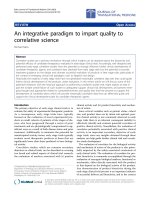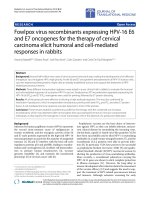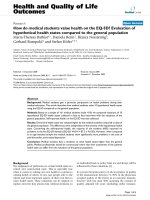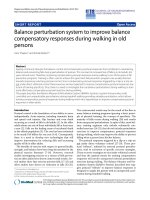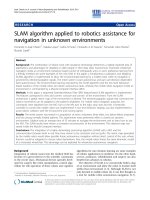Báo cáo hóa học: " Chikungunya virus adapts to tiger mosquito via evolutionary convergence: a sign of things to come?" potx
Bạn đang xem bản rút gọn của tài liệu. Xem và tải ngay bản đầy đủ của tài liệu tại đây (502.56 KB, 4 trang )
BioMed Central
Page 1 of 4
(page number not for citation purposes)
Virology Journal
Open Access
Short report
Chikungunya virus adapts to tiger mosquito via evolutionary
convergence: a sign of things to come?
Xavier de Lamballerie*
1
, Eric Leroy
2
, Rémi N Charrel
1
,
Konstantin Ttsetsarkin
3
, Stephen Higgs
3
and Ernest A Gould
1
Address:
1
Institut de Recherche pour le Développement UMR190/Unité des Virus Emergents, Université de la Méditerranée, Marseille, France,
2
Institut de Recherche pour le Développement UMR190/CIRMF, Franceville, Gabon and
3
Department of Pathology, University of Texas Medical
Branch, Galveston, Texas, USA
Email: Xavier de Lamballerie* - ; Eric Leroy - ; Rémi N Charrel -
mrs.fr; Konstantin Ttsetsarkin - ; Stephen Higgs - ; Ernest A Gould -
* Corresponding author
Abstract
Since 2004, several million indigenous cases of Chikungunya virus disease occurred in Africa, the
Indian Ocean, India, Asia and, recently, Europe. The virus, usually transmitted by Aedes aegypti
mosquitoes, has now repeatedly been associated with a new vector, Ae. Albopictus. Analysis of full-
length viral sequences reveals three independent events of virus exposure to Ae. Albopictus, each
followed by the acquisition of a single adaptive mutation providing selective advantage for
transmission by this mosquito. This disconcerting and current unique example of "evolutionary
convergence" occurring in nature illustrates rapid pathogen adaptation to ecological perturbation,
driven directly as a consequence of human activities.
Findings
Mosquito-transmitted Chikungunya virus (CHIKV) is
responsible for explosive outbreaks of febrile arthralgia in
humans [1,2]. Several evolutionary lineages have been
identified (fig-1) corresponding to, Western-Africa, Asia,
East/South-Africa and Central-Africa [3]. Phylogenetic
analyses of full-length genomes reveal that CHIKV is read-
ily transported by infected travellers to distant locations
where it generates new outbreaks (fig-2). This propensity
for dispersal and emergence in remote ecological environ-
ments illustrates the adaptability of the virus, in particular
to new vector populations.
Until recently, during human outbreaks, the principal
identified vector of CHIKV was Ae. aegypti. However,
CHIKV has been recently associated with an alternative
vector, Ae. Albopictus (the "Asian Tiger Mosquito"), which
has spread in areas previously occupied predominantly by
Ae. aegypti, and dispersed globally via commercial trans-
portation of, for example scrap car tyres [4].
During the 2004 epidemic in Kenya and the subsequent
outbreaks, when CHIKV was introduced into Comoros
and Seychelles, CHIKV was transmitted by Ae. aegypti. Pre-
vious studies showed that Ae. Aegypti-associated CHIKV
isolates from Comoros and Seychelles, as well as early iso-
lates from other islands in this region, had an Alanine res-
idue at position 226 of the E1 gene [5]. However, when
the virus reached Reunion and Mauritius Islands, it met
different ecological environments in which Ae. aegypti is
absent or scarce and Ae. albopictus predominates. Within
one year, a new mutation (A226V, ie a Valine residue at
Published: 27 February 2008
Virology Journal 2008, 5:33 doi:10.1186/1743-422X-5-33
Received: 11 January 2008
Accepted: 27 February 2008
This article is available from: />© 2008 de Lamballerie et al; licensee BioMed Central Ltd.
This is an Open Access article distributed under the terms of the Creative Commons Attribution License ( />),
which permits unrestricted use, distribution, and reproduction in any medium, provided the original work is properly cited.
Virology Journal 2008, 5:33 />Page 2 of 4
(page number not for citation purposes)
position 226) was identified in some CHIKV samples [5].
The virus also reached Madagascar and Mayotte, where
both Ae. aegypti and Ae. albopictus are common. The
A226V mutation was identified in all sequenced 2006
Mayotte isolates [5] and in a recent 2007 Madagascan iso-
late (this study). This suggests that this mutation is associ-
ated with adaptation to Ae. Albopictus and, indeed, we
have recently shown that it improves virus replication and
transmission efficiency in this mosquito [6]. To conclude,
in all Indian Ocean islands where Ae. albopictus is present,
the A226V adaptive mutation was observed 1 or 2 years
after the introduction of CHIKV. Whether this mutation
was acquired several times independently or if an "Ae.
albopictus-adapted" strain evolved in one island and then
dispersed to neighbouring islands is unknown.
The situation is different in India. Our phylogenetic anal-
yses suggest that CHIKV originating from East-Africa or
Comoros was introduced into India in 2006 (fig-1&2). In
2007, an infected traveller from India arrived in Italy and
caused more than 200 indigenous cases of chikungunya.
The Italian strain ITA07-RA1 (GenBank_EU244823
) has
the A226V mutation, acquired in Italy (where Ae. albopic-
tus is present) or, more probably, in India (where both Ae.
aegypti and albopictus are present). Since 2006 Indian iso-
lates originate from an ancestor with an Alanine at posi-
tion 226 (fig-1), the A226V mutation must have been
acquired independently from the identical mutation of
the Indian Ocean isolates. Additional evidence supports
the case for independent mutations. Chikungunya out-
breaks were observed in Cameroon (2006) and Gabon
Chikungunya virus dispersal and evolutionFigure 1
Chikungunya virus dispersal and evolution. Phylogenetic trees were produced using alignments of complete or nearly-
complete Chikungunya virus nucleotide sequences, from which the E1 226 codon was removed. Bootstrap resampling values
are indicated at the main branches. Strains with the A226V mutation are indicated. In the tree on the right, horizontal bars are
proportional to genetic distances. The tree on the left shows only the topology of the reconstruction. Branches supported by
a bootstrap <60 are collapsed. Colours that identify the different lineages are the same as in figure 2. Central African strains
that have been assigned to a given lineage based only on partial sequencing of the E1 gene are indicated in the exploded yellow
bubble (a phylogenetic branch reconstructed from E1 sequences is shown). Isolates in the East-South-Africa, Asia and West-
Africa lineages, which have been characterised only in the E1 gene are indicated.
Virology Journal 2008, 5:33 />Page 3 of 4
(page number not for citation purposes)
(2007) [2], where Ae. albopictus has displaced Ae. aegypti.
CHIKV strains from both outbreaks originate from the
Central-African lineage (ie, are distinct from Indian/
Indian Ocean isolates from the same period), but, in con-
trast to original Central-African strains (transmitted by Ae.
aegypti) both the Cameroon (Chik_Cam_7079,
GenBank_EF051584
) and Gabon (this study) isolates
have the A226V mutation. This implies an independent
adaptive mutation in response to a similar requirement of
transmission by Ae. albopictus.
It is extremely rare for this phenomenon, known as "evo-
lutionary convergence", to be observed in nature. In virol-
ogy, convergent mutations have been reported under the
extreme selective pressure of antiviral therapy during the
treatment of acute (eg neuraminidase mutations of influ-
enza virus) or chronic (eg reverse-transcriptase/protease
mutations of HIV) viral diseases. Our results demonstrate
that the selective pressure exerted on CHIKV through the
constraint of having to replicate in a new vector, is similar
to that cited for antiviral therapy. Since the dispersal of Ae.
albopictus from Asia to Europe and the Americas is largely
the result of human commercial activities, the adaptation
of CHIKV to Ae. albopictus provides a fascinating demon-
stration of how viruses can readily circumvent the impact
of human interference on the ecosystem. Our observa-
tions also have very serious implications for future emerg-
ing arboviruses that infect humans. Aedes albopictus, which
has dispersed into central Africa is also becoming wide-
spread in Europe and North-America. Thus, CHIKV, and
possibly other tropical arboviruses, have the potential to
invade more northerly geographic regions.
Abbreviations
CHIKV: Chikungunya virus.
Competing interests
The authors declare that they have no competing interests.
Authors' contributions
XdL led and coordinated the project and the manuscript
redaction, realised phylogenetic analysis. EL isolated and
characterised Gabon strains (viral genomics), was
involved in data analysis and manuscript redaction. RNC
isolated and characterised Madagascar strains (viral
genomics), was involved in data analysis and manuscript
redaction. KT characterised Reunion strains, made sub-
stantial contribution to analysis, have been involved in
Predicted dispersal pattern of Chikungunya virus from Africa to the Indian Ocean and Europe during the past 20 to 50 yearsFigure 2
Predicted dispersal pattern of Chikungunya virus from Africa to the Indian Ocean and Europe during the past 20 to 50 years.
Publish with BioMed Central and every
scientist can read your work free of charge
"BioMed Central will be the most significant development for
disseminating the results of biomedical research in our lifetime."
Sir Paul Nurse, Cancer Research UK
Your research papers will be:
available free of charge to the entire biomedical community
peer reviewed and published immediately upon acceptance
cited in PubMed and archived on PubMed Central
yours — you keep the copyright
Submit your manuscript here:
/>BioMedcentral
Virology Journal 2008, 5:33 />Page 4 of 4
(page number not for citation purposes)
manuscript redaction. SH made substantial contribution
to analysis and interpretation of data, was involved in
manuscript redaction. EAG substantially contributed to
phylogenetic analysis and interpretation of data, was
involved in manuscript redaction. All authors approved
final version of the manuscript.
References
1. Johnston RE, Peters CJ: Alphaviruses. In Fields Virology Volume 1. 3rd
edition. Edited by: Fields BN, Knipe DM, Howley PM, Chanock RM,
Melnick JL, Monath TP, Roisman B, Straus SE. Philadelphia: Lippincott-
Raven publishers; 1996:843-898.
2. Anonymous: Outbreak and spread of chikungunya. Wkl Epi-
demio Rec 2007, 82:409-416.
3. Powers AM, Brault AC, Tesh RB, Weaver SC: Re-emergence of
Chikungunya and O'nyong-nyong viruses: evidence for dis-
tinct geographical lineages and distant evolutionary relation-
ships. J Gen Virol 2000, 81:471-479.
4. Charrel RN, de Lamballerie X, Raoult D: Chikungunya outbreaks-
the globalization of vectorborne diseases. N Engl J Med 2007,
356:769-771.
5. Schuffenecker I, Iteman I, Michault A, Murri S, Frangeul L, Vaney MC,
Lavenir R, Pardigon N, Reynes JM, Pettinelli F, Biscornet L, Diancourt
L, Michel S, Duquerroy S, Guigon G, Frenkiel MP, Bréhin AC, Cubito
N, Desprès P, Kunst F, Rey FA, Zeller H, Brisse S: Genome micro-
evolution of chikungunya viruses causing the Indian Ocean
outbreak. PLoS Med 2006, 3:e263.
6. Tsetsarkin KA, Vanlandingham DL, McGee CE, Higgs S: A Single
Mutation in Chikungunya Virus Affects Vector Specificity
and Epidemic Potential. PLoS Pathog 2007, 12:e201.

